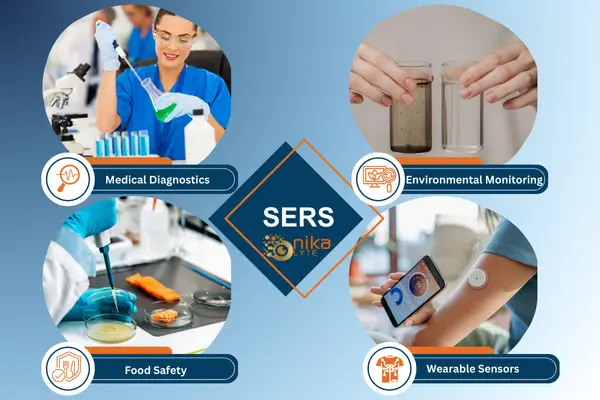Surface-Enhanced Raman Scattering (SERS) has rapidly gained recognition as a groundbreaking biosensing technique, enabling the accurate, rapid, and non-invasive detection of diseases, pathogens, and environmental toxins. By significantly amplifying Raman signals through nanomaterials, SERS makes it possible to detect trace amounts of biological analytes, positioning it as a leading method for medical diagnostics, food safety, and environmental monitoring. [1]
In this blog, we’ll explore how SERS is revolutionizing the field of biosensing technology and its diverse applications across healthcare, food safety, and the environment.
What is Surface-Enhanced Raman Scattering (SERS)?
Surface-Enhanced Raman Scattering (SERS) is a powerful analytical technique that enhances the sensitivity of Raman spectroscopy, allowing for the detection of molecules at ultra-low concentrations. While traditional Raman spectroscopy provides valuable molecular fingerprints by analyzing scattered light, its weak signal limits its application to bulk detection. By utilizing nanotextured metal like gold, silver, or copper, SERS amplifies the Raman signal significantly, allowing for the detection of even single molecules with high precision.[2]
Recent innovations in SERS technology have led to the development of high-performance, multifunctional SERS substrates, propelling Raman sensing into new and diverse application areas. These advancements have been particularly impactful in biological analysis, offering fast, reliable, and sensitive detection methods for a range of analytes, including viruses, biomarkers, and pathogens.
How Does SERS Work for Biosensing?
SERS works by enhancing the Raman signal through two primary mechanisms:
- Electromagnetic Enhancement: Metal nanostructures, such as nanoparticles or roughened metal surfaces, create localized electromagnetic fields that significantly amplify the Raman signal of nearby molecules.
- Chemical Enhancement: The interaction between the analyte and the metal surface alters molecular polarization, further boosting the Raman scattering intensity.
Together, these effects enable SERS biosensors to detect even the smallest amounts of molecules in complex biological samples. This makes SERS an invaluable tool for detecting pesticides, viruses, and biomarkers, particularly in non-invasive applications like medical diagnostics.[3]
Why SERS is Ideal for Biosensing?
- High Sensitivity: SERS can detect molecules at femtomolar or picomolar concentrations, making it perfect for identifying rare biomarkers and pathogens.[4]
- Label-Free Detection: SERS eliminates the need for labels (such as fluorescent tags), simplifying the analysis process and minimizing interference.[5]
- Real-Time Monitoring: SERS allows for continuous, in-situ monitoring of biological processes, which is crucial for point-of-care diagnostics.[6]
- Multiplexing: SERS enables the simultaneous detection of multiple targets using different nanostructures, increasing the efficiency and throughput of biosensing.[7]
- Non-Invasive: SERS sensors can analyze biological fluids like blood, saliva, and urine, offering a non-invasive, patient-friendly approach to disease detection.[8]
Applications of SERS in Biosensing
- Medical Diagnostics: SERS is increasingly being used for early disease detection. Its high sensitivity allows for the identification of cancer biomarkers, viral pathogens, and other diseases at their initial stages, often before clinical symptoms appear.
- Environmental Monitoring: SERS is a highly effective technique for detecting pollutants and hazardous compounds in the environment. It enables real-time monitoring of contaminants in air, water, and soil. [10]
- Water Quality Testing: SERS can detect trace amounts of pollutants like pesticides and pharmaceutical residues in water sources.
- Air Quality Monitoring: SERS sensors can identify volatile organic compounds (VOCs) and other air pollutants, helping to improve environmental health and control pollution.
- Food Safety: SERS is invaluable in ensuring food safety by enabling the rapid detection of pathogens like E. coli, Salmonella, and Listeria. This helps maintain quality control and minimize the risk of foodborne illnesses.[11]
- Wearable Sensors for Continuous Monitoring: Researchers are exploring the use of SERS in wearable biosensors, which would allow for continuous, non-invasive monitoring of biomarkers such as glucose levels in diabetic patients. This would support better disease management and personalized healthcare solutions.[12]
Key Challenges Facing SERS in Biosensing Applications
- Reproducibility: Achieving consistent results in nanomaterial fabrication is difficult. Variability in the size and shape of nanoparticles can affect the enhancement factor, leading to inconsistent results.[13]
- Nanomaterial Optimization: The choice of metal and the shape of nanoparticles directly influence the SERS performance. Ongoing research is focused on designing more stable nanostructures with higher Raman enhancement. [2]
- Biological Interference: Complex biological samples can interfere with the SERS signal. Strategies to reduce background noise and enhance the specificity of the sensors are crucial for improving reliability and reduce the incidence of false negatives.[14]
- Detection of Macromolecules: Although SERS can detect small molecules at femtomolar or atto-molar concentrations, detecting macromolecules like proteins and DNA remains challenging. Special efforts, such as improving nanostructure design and using labelling methods, are being explored to improve sensitivity for larger molecules.[15]
Why Choose Nikalyte SERS?
Nikalyte’s Gold and Silver SERS substrates utilise ultra-pure, hydrocarbon-free nanoparticles, ensuring enhanced sensitivity and accuracy. With up to 1000x signal amplification, our substrates detect analytes at parts-per-billion levels, surpassing traditional Raman methods. Ideal for both lab and field use, they provide real-time, reliable results without drying or special preparations.[16] Trusted globally in healthcare, pharmaceuticals, forensics, and environmental monitoring, Nikalyte SERS is known for its high specificity, fast results, and easy handling.
Conclusion
Surface-Enhanced Raman Scattering (SERS) has become one of the most promising technologies in the biosensing industry, offering ultra-high sensitivity, real-time detection, and label-free analysis. Its ability to detect low-concentration biomarkers, pathogens, and environmental toxins makes it a powerful tool for medical diagnostics, environmental monitoring, and food safety. With continued advancements in nanomaterials and sensor integration, SERS holds immense potential for transforming the field of diagnostics.
Although SERS has made significant progress, challenges such as stability, signal reproducibility, and background interference must still be addressed to facilitate broader adoption, especially in Point-of-Care (POC) applications. Nevertheless, the revolutionary capabilities of SERS in personalized healthcare, environmental protection, and food safety ensure that it will play a central role in the next generation of biosensors. As these challenges are overcome, SERS is poised to become a key technology in the future of rapid, precise diagnostics.
For top-tier SERS performance, choose Nikalyte’s Gold and Silver SERS substrates , the ideal solution for your diagnostic needs.
References:
- Tran, V. A., Tran, T. T. V., Le, V. T., Doan, V. D., Vo, G. N. L., Tran, V. H., Jeong, H., & Vo, T. T. T. (2024). Advanced nano engineering of surface-enhanced Raman scattering technologies for sensing applications. Applied Materials Today, 38, 102217. https://doi.org/10.1016/j.apmt.2024.102217
- Lin, C., Li, Y., Peng, Y., et al. (2023). Recent development of surface-enhanced Raman scattering for biosensing. Journal of Nanobiotechnology, 21(149). https://doi.org/10.1186/s12951-023-01890-7
- Chen, K., Ong, Y.H., Yuen, C., & Liu, Q. (2016). Surface-enhanced Raman spectroscopy for intradermal measurements. In M.R. Hamblin, P. Avci, & G.K. Gupta (Eds.), Imaging in Dermatology (pp. 141-154). Academic Press. https://doi.org/10.1016/B978-0-12-802838-4.00013-3
- Lyu, N., Hassanzadeh-Barforoushi, A., Rey Gomez, L.M., et al. (2024). SERS biosensors for liquid biopsy towards cancer diagnosis by detection of various circulating biomarkers: Current progress and perspectives. Nano Convergence, 11, 22. https://doi.org/10.1186/s40580-024-00428-3
- Geka, G., Kanioura, A., Likodimos, V., Gardelis, S., Papanikolaou, N., Kakabakos, S., & Petrou, P. (2023). SERS immunosensors for cancer markers detection. Materials, 16(10), 3733. https://doi.org/10.3390/ma16103733
- Oliveira, D., Carneiro, M. C. C. G., & Moreira, F. T. C. (2024). SERS biosensor with plastic antibodies for detection of a cancer biomarker protein. Mikrochimica Acta, 191(5), 238. https://doi.org/10.1007/s00604-024-06327-y
- Xie, Y., Xu, J., Shao, D., Liu, Y., Qu, X., Hu, S., & Dong, B. (2025). SERS-based local field enhancement in biosensing applications. Molecules, 30(1), 105. https://doi.org/10.3390/molecules30010105
- Constantinou, M., Hadjigeorgiou, K., Abalde-Cela, S., & Andreou, C. (2022). Label-free sensing with metal nanostructure-based surface-enhanced Raman spectroscopy for cancer diagnosis. ACS Applied Nano Materials, 5(9), 12276–12299. https://doi.org/10.1021/acsanm.2c02392
- Usman, M., Tang, J.-W., Li, F., Lai, J.-X., Liu, Q.-H., Liu, W., & Wang, L. (2023). Recent advances in surface-enhanced Raman spectroscopy for bacterial pathogen identifications. Journal of Advanced Research, 51, 91–107. https://doi.org/10.1016/j.jare.2022.11.010
- Terry, L. R., Sanders, S., Potoff, R. H., Kruel, J. W., Jain, M., & Guo, H. (2022). Applications of surface-enhanced Raman spectroscopy in environmental detection. Analytical Science Advances. https://doi.org/10.1002/ansa.202200003
- Law, J. W., Ab Mutalib, N. S., Chan, K. G., & Lee, L. H. (2015). Rapid methods for the detection of foodborne bacterial pathogens: Principles, applications, advantages and limitations. Frontiers in Microbiology, 5, 770. https://doi.org/10.3389/fmicb.2014.00770
- Harun-Or-Rashid, M., Aktar, M. N., Preda, V., & Nasiri, N. (2024). Advances in electrochemical sensors for real-time glucose monitoring. Sensors & Diagnostics, 3, 893-913. https://doi.org/10.1039/D4SD00086B
- Logan, N., Cao, C., Freitag, S., Haughey, S. A., Krska, R., & Elliott, C. T. (2024). Advancing mycotoxin detection in food and feed: Novel insights from surface-enhanced Raman spectroscopy (SERS). Advanced Materials, 36(1), 202309625. https://doi.org/10.1002/adma.202309625
- Vázquez-Iglesias, L., Stanfoca Casagrande, G. M., García-Lojo, D., Ferro Leal, L., Ngo, T. A., Pérez-Juste, J., Reis, R. M., Kant, K., & Pastoriza-Santos, I. (2023). SERS sensing for cancer biomarker: Approaches and directions. Bioactive Materials, 19, 115-132. https://doi.org/10.1016/j.bioactmat.2023.12.018
- Shiohara, A., Wang, Y., & Liz-Marzán, L. M. (2014). Recent approaches toward creation of hot spots for SERS detection. Journal of Photochemistry and Photobiology C: Photochemistry Reviews, 21, 10-23. https://doi.org/10.1016/j.jphotochemrev.2014.09.001


